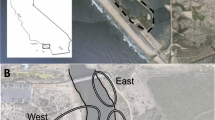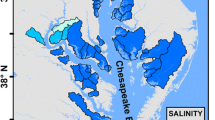Abstract
This study collected new data on sediment thickness and distribution and integrated it with existing data on the distribution of plant species within a small (0.5 ha) created, tidal salt marsh in Langley, Virginia, USA. The presence of the reedPhragmites australis was found to be inversely correlated with sediment accumulation on the marsh surface. Sediment-deficient areas seem at a higher risk for invasion byP. australis and subsequent loss of designed marsh habitat. The results indicate that areas of low sediment accumulation may be used as a proxy measure for areas vulnerable to invasion. These areas can be easily delimited both in the field and on aerial photography.
Similar content being viewed by others
Literature Cited
Barnard, T.A. Jr. and P.A. Mason. 1990. Compensatory mitigation within the tidal wetlands of Virginia. Virginia Institute of Marine Science, Gloucester Point, VA, USA. Technical Report 90–7.
Blanch, S.J. and M.A. Brock. 1994. Effects of grazing and depth on two wetland plant species. Australian Journal of Marine and Freshwater Research 45(8):1387–1394.
Cross, D.H. and K.L. Fleming. 1989. Control of Phragmites or Common Reed. U.S. Fish and Wildlife Service, Washington, DC. USA. Fish and Wildlife Leaflet 13.4.12.
Hara, T., J. Van der Toorn, and J. H. Mook. 1993. Growth dynamics and size structure of shoots ofPhragmites australis, a clonal plant. Journal of Ecology 81:47–60.
Haslam, S.M. 1969. Stem types ofPhragmites communis Trin. Annuals of Botany 33:127–131.
Haslam, S.M. 1971. Community regulation inPhragmites communis Trin. II. Mixed Stands. Journal of Ecology 59:75–87.
Havens, K. J., W.I. Priest III. and H. Berquist 1997. Invèstigation and long-term monitoring ofPhragmites australis within Virginia’s created wetland sites. Environmental Management 21:599–605.
Helpings, S.E. and J.L. Gallagher. 1992. The effects of salinity and flooding onPhragmites australis. Journal of Applied Ecology 29:41–49.
Jones, W.L. and W.C. Lehman. 1987. Phragmites control and revegetation following the acrial application of glyphosate in Delaware. p. 185–199.In W.R. Witman and W.H. Meredith (eds.) Waterfowl and Wetlands Symposium. Delaware Coastal Management Program, Delaware Department of Natural Resources and Environmental Control, Dover, DE, USA.
Kludze, H. K. and R. D. Delaune. 1996. Soil redox intensity effects on oxygen exchange and growth of cattail and sawgrass. Soil Science Society of America Journal 60:616–621.
Marks, M., Lapin, B., and J. Randall. 1994.Phragmites australis (P. communis): Threats, management, and monitoring, Natural Areas Journal 14:285–294.
Sanchez, J. M., X.L. Otero, and J. Izco. 1998. Relationships between vegetation and environmental characteristics in a salt-marsh system on the coast of Northeastern Spain. Plant Ecology 135:1–8.
Silberhorn, G. 1991. Reed grass Phragmites. Technical Report Wetland Flora. Wetlands Program, Virginia Institute of Marine Science, Gloucester Point VA, USA.
Templer, P., S. Findlay, and C. Wigand. 1998. Sediment chemistry associated with native and non-native emergent macrophytes of a Hudson marsh ecosystem. Wetlands 18:70–78.
Weisner, S.E.B. 1996. Effects of an organic sediment on performance of youngPhragmites australis clones at different water depth treatments. Hydrobiologia 330:189–194.
Weisner, S.E.B. and W. Graneli. 1989. Influence of substrate conditions on the growth ofPhragmites australis after a reduction in oxygen transport to below-ground parts. Aquatic Botany 35:71–80.
Author information
Authors and Affiliations
Corresponding author
Rights and permissions
About this article
Cite this article
Pyke, C.R., Havens, K.J. Distribution of the invasive reedPhragmites australis relative to sediment depth in a created wetland. Wetlands 19, 283–287 (1999). https://doi.org/10.1007/BF03161758
Received:
Revised:
Accepted:
Issue Date:
DOI: https://doi.org/10.1007/BF03161758




